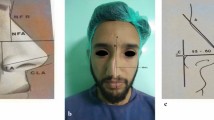Abstract
Patients perceive the pulling of a nasal splints as the most feared and stressful part of nasal surgery. Even the incisions made for alar base surgery can partly or entirely dehisce. So, we have been using modified Doyle silicone splints. We compared the modified Doyle silicone splints with conventional Doyle silicone splint. Included in the study were 64 patients undergoing alar base surgery together with open septorhinoplasty. Group 1 (n = 32) patients received a conventional Doyle intranasal silicone splint and group 2 (n = 32) received modified splint that we call a hemi-split Doyle splint. The pain felt by the patients during the removal of the splints was recorded according to the visual analogue scale (VAS). On days two and four postoperatively, the nasal stuffiness score (NOSE) was recorded. On day four postoperatively an intranasal examination was conducted to establish if dehiscence had occurred on the alar base incision line. In group 2, the pain scores during splints removal were significantly lower than those in group 1. Whereas no dehiscence on the alar base incision line was observed after tampon removal in group 2, the incision dehisced in eight patients in group 1. The NOSE scores on postoperative days two and four showed no difference between the groups. The hemi-split Doyle splint causes less pain during removal and particularly does not lead to dehiscence of incisions made during alar base surgery in rhinoplasty patients.




Similar content being viewed by others
References
Foda HMT (2011) Alar base reduction: the boomerang-shaped excision. Fac Plast Surg 27:225–233. doi:10.1055/s-0030-1271302
Ilhan AE, Eser BC, Cengiz B (2017) “The magic finger technique” a simplified approach for more symmetric results in alar base resection. pp 137–142. doi:10.1007/s00238-016-1239-x
Bresnihan M, Mehigan B, Curran A (2007) An evaluation of Merocel and Series 5000 nasal packs in patients following nasal surgery: a prospective randomised trial. Clin Otolaryngol 32:352–355. doi:10.1111/j.1749-4486.2007.01517.x
Orlandi RR, Lanza DC (2004) Is nasal packing necessary following endoscopic sinus surgery? Laryngoscope 114:1541–1544. doi:10.1097/00005537-200409000-00007
Guyuron B, Vaughan C (1995) Evaluation of stents following septoplasty. Aesthet Plast Surg 19:75–77. doi:10.1007/BF00209314
Piatti G, Scotti A, Ambrosetti U (2004) Nasal ciliary beat after insertion of septo-valvular splints. Otolaryngol Head Neck Surg 130:558–562. doi:10.1016/j.otohns.2003.07.013
Yilmaz MS, Guven M, Buyukarslan DG (2012) Do silicone nasal septal splints with integral airway reduce postoperative eustachian tube dysfunction? Otolaryngol Neck Surg 146:141–145. doi:10.1177/0194599811421595
Asaka D, Yoshikawa M, Okushi T (2012) Nasal splinting using silicone plates without gauze packing following septoplasty combined with inferior turbinate surgery. Auris Nasus Larynx 39:53–58. doi:10.1016/j.anl.2011.01.024
Jung YG, Hong JW, Eun Y-G, Kim M-G (2011) Objective usefulness of thin silastic septal splints after septal surgery. Am J Rhinol Allergy 25:182–185. doi:10.2500/ajra.2011.25.3584
Gunaydin RO, Aygenc E, Karakullukcu S (2011) Nasal packing and transseptal suturing techniques: surgical and anaesthetic perspectives. Eur Arch Otorhinolaryngol 268:1151–1156. doi:10.1007/s00405-011-1542-x
Kayahan B, Ozer S, Suslu AE (2017) The comparison of the quality of life and intranasal edema between the patients with or without nasal packing after septoplasty. Eur Arch Otorhinolaryngol 274:1551–1555. doi:10.1007/s00405-016-4403-9
Stewart MG, Witsell DL, Smith TL et al (2004) Development and validation of the Nasal Obstruction Symptom Evaluation (NOSE) Scale. Otolaryngol Head Neck Surg 130:157–163. doi:10.1016/j.otohns.2003.09.016
Ozkırış M, Kapusuz Z, Saydam L (2013) Comparison of nasal packs with transseptal suturing after nasal septal surgery. Am J Otolaryngol 34:308–311. doi:10.1016/j.amjoto.2012.12.012
Acıoğlu E, Edizer DT, Yiğit Ö (2012) Nasal septal packing: which one? Eur Arch Otorhinolaryngol 269:1777–1781. doi:10.1007/s00405-011-1842-1
Salinger S, Cohen BM (1955) Surgery of the difficult septum. AMA Arch Otolaryngol 61:419–421
Doyle DE, House LF, Hall WP (1977) Description of a new device: an intranasal airway/splint. Laryngoscope 87:608–612. doi:10.1288/00005537-197704000-00013
Cayonu M, Acar A, Horasanlı E (2014) Comparison of totally occlusive nasal pack, internal nasal splint, and transseptal suture technique after septoplasty in terms of immediate respiratory distress related to anesthesia and surgical complications. Acta Otolaryngol 134:390–394. doi:10.3109/00016489.2013.878476
Cruise AS, Amonoo-Kuofi K, Srouji I (2006) A randomized trial of Rapid Rhino Riemann and Telfa nasal packs following endoscopic sinus surgery. Clin Otolaryngol 31:25–32. doi:10.1111/j.1749-4486.2006.01122.x
Author information
Authors and Affiliations
Corresponding author
Ethics declarations
Conflict of interest
The authors declared no potential conflicts of interest with respect to the research, authorship, and publication of this article.
Ethical approval
All procedures performed in studies involving human participants were in accordance with the ethical standards of the institutional and/or national research committee and with the 1964 Helsinki declaration and its later amendments or comparable ethical standards.
Informed consent
Informed consent was obtained from all individual participants included in the study.
Funding
This study was not funded. The authors received no financial support for the research and/or authorship of this article.
Rights and permissions
About this article
Cite this article
Koçak, İ., Şentürk, E. A new modification of Doyle splint (Hemi-split Doyle) in rhinoplasty with alar base reduction. Eur Arch Otorhinolaryngol 274, 3667–3672 (2017). https://doi.org/10.1007/s00405-017-4701-x
Received:
Accepted:
Published:
Issue Date:
DOI: https://doi.org/10.1007/s00405-017-4701-x




